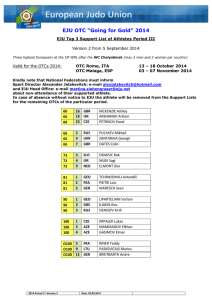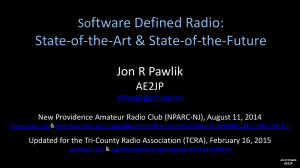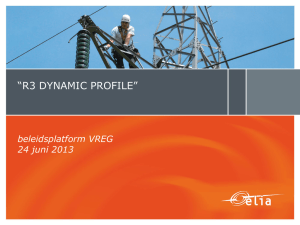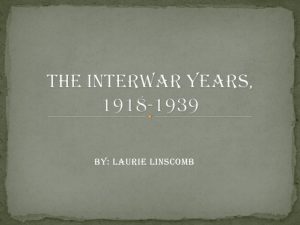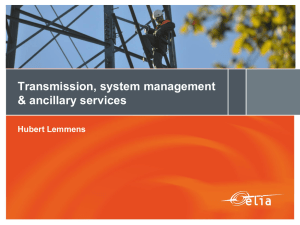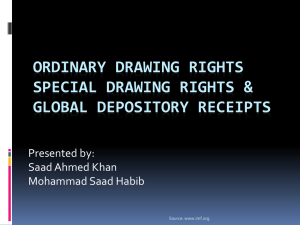Presentation by Elia: Agenda, planning and status update
advertisement
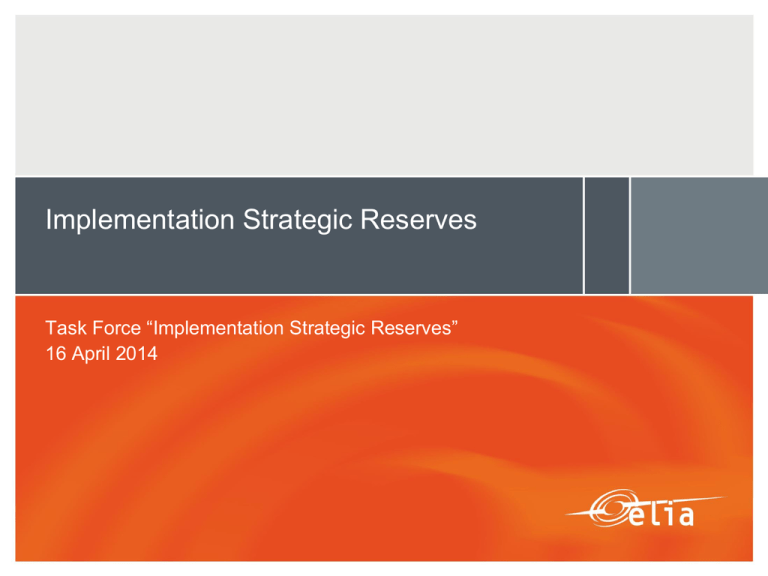
Implementation Strategic Reserves Task Force “Implementation Strategic Reserves” 16 April 2014 Agenda TF ISR – 16/4/2014 (9h00-13h00) Location: Elia, Keizerslaan 20, 1000 Brussels Topic Presenter Time Approval of draft minutes 3rd TF ISR 16/4/2014 Elia 10 minutes Status and planning update Elia 15 minutes Procedure to constitute the SR Consolidating feedback and highlighting recent evolutions, incl. calibration Elia 2 hours 20 minutes BREAK 15 minutes Market design Structural shortage, imbalance pricing, technical trigger Elia 50 minutes Next steps Impacts on other elements (e.g. ARP contract) Elia 10 minutes TF ISR – 16/4/2014 2 Agenda START: 9h00 • Approval of draft minutes TF ISR 19/3/’14 9h10 • Status and planning update 9h25 • Procedure to constitute the SR a) Parameter calibration b) Overview of the procedure BREAK: 11h45 Coffee Break 12h00 • Market design ( functioning rules) 12h50 • Next steps END: 13h00 TF ISR – 16/4/2014 3 Introduction Approval of minutes 3rd TF ISR 19/3/2014 The draft minutes were distributed by e-mail prior to this meeting. No specific comments on the minutes have been received. TF ISR – 16/4/2014 4 Agenda START: 9h00 • Approval of draft minutes TF ISR 19/3/’14 9h10 • Status and planning update 9h25 • Procedure to constitute the SR a) Parameter calibration b) Overview of the procedure BREAK: 11h45 Coffee Break 12h00 • Market design ( functioning rules) 12h50 • Next steps END: 13h00 TF ISR – 16/4/2014 5 Introduction Update planning 2014/2015 • The law amending the Law of 29 April 1999 on the organization of the electricity market, which provides for the establishment of a mechanism of strategic reserves has been published in the ‘Belgisch Staatsblad / Moniteur Belge’. • Conform the approved transitional calendar, Elia has submitted to the AD Energy an analysis of the security of supply of the country, the AD Energy has delivered an advice to the Minister on the need to constitute a strategic reserve and the Minister has instructed Elia by Ministerial decree to constitute a strategic reserve of 800MW for the next three years. All these documents have been published on the website of the AD Energy. • The next steps are the finalization of the public consultation on the procedure for constitution of strategic reserves, foreseen by April 25th. • And the submission of the functioning rules of the strategic reserves for approval to the CREG, also foreseen for April 25th. TF ISR – 16/4/2014 6 Introduction Volumes decided by the Minister • The procedure for constitution of strategic reserves as sent for final consultation, has taken into account the Ministerial Decree of April 3rd. As described in point 2.5 of the procedure, art.1 of the Ministerial Decree stipulates that: - A volume of 800MW needs to be constituted as strategic reserves, for a period of three years and that this volume needs to be composed from capacity that would have been out of the market on November 1st 2014, if it weren’t for the mechanism of strategic reserves. - Furthermore, demand capacity can only be contracted for one year, which is in derogation to production capacity, which can contribute to the determined volume for the three years. This is translated into the eligibility criteria, to be discussed in the part on Tender Design. - There is a possibility foreseen to increase the determined volume should there be credible indicators that D3/T2 would not be back to the market before the winter period. No new tender will be organized, but only non-selected offers to constitute the 800MW can be additionally contracted in this case. TF ISR – 16/4/2014 7 Introduction Update on consultation planning Procedure for constitution of strategic reserves A draft version of this procedure was sent ta all taskforce members and is also available on our website for final consultation by all stakeholders (grid users, producers, the regulator, the energy administration,...) This version already takes into account all comments received during and in between the consultations that took place via the Taskforces for Implementation of Strategic Reserves. TF iSR I 17/2 2014 feb TF iSR III 19/3 mrt 28/2 TF iSR II TF iSR IV 16/4 apr TF iSR V ? 10/06 or 19/06 mei Today jun 05/5 Call For Candidates 2014 10/6 Call For Tender Consultation process: • Any comments are to be sent to Filip Carton no later than 25 April, 23h59; • Unless stakeholders clearly indicate that comments are confidential these will be made public via our website; • In case there are any comments to be made, they can also be discussed during today’s Task Force; • Prior to the call for candidates (actually planned to start on 5 May 2014) a final version will be published on our website in NL, FR and UK; TF ISR – 16/4/2014 8 Questions TF ISR – 16/4/2014 9 Agenda START: 9h00 • Approval of draft minutes TF ISR 19/3/’14 9h10 • Status and planning update 9h25 • Procedure to constitute the SR a) Parameter calibration b) Overview of the procedure BREAK: 11h45 Coffee Break 12h00 • Market design ( functioning rules) 12h50 • Next steps END: 13h00 TF ISR – 16/4/2014 10 Agenda START: 9h00 • Approval of draft minutes TF ISR 19/3/’14 9h10 • Status and planning update 9h25 • Procedure to constitute the SR a) Parameter calibration b) Overview of the procedure BREAK: 11h45 Coffee Break 12h00 • Market design ( functioning rules) 12h50 • Next steps END: 13h00 TF ISR – 16/4/2014 11 Content Part 1: Introduction Part 2: Parameters used for computation of total cost during selection Specific scenario of activations Part 3: SDR product design Nature of SDR Calibration of parameter Part 4: Ratio SDR/SGR TF ISR – 16/4/2014 12 Content Part 1: Introduction Part 2: Parameters used for computation of total cost during selection Specific scenario of activations Part 3: SDR product design Nature of SDR Calibration of parameter Part 4: Ratio SDR/SGR TF ISR – 16/4/2014 13 Introduction Volume for strategic reserves determined by Monte Carlo simulation. Simulation of available production versus predicted demand Available production - Installed capacity Taken into account - Solar/wind/hydro/import Maintenance Forced outages Predicted demand - Multiple timeseries Outcomes of simulations used as parameters: LOLE = Loss of Load expected = # hours during which the injection capacity (installed productions and imports) does not cover the load consumption ENS = Energy not Served during those moments Probability of activation Remark: for all parameters we distinguish • Average values used for example for the determination of the selection scenario • Extreme values used for the calibration of products: P95 example • Average values of LOLE • Extreme values of LOLE (P95 or LOLE95) representing worst case scenario’s of the MC simulations TF ISR – 16/4/2014 14 Content Part 1: Introduction Part 2: Parameters used for computation of total cost during selection Specific scenario of activations Part 3: SDR product design Nature of SDR Calibration of parameter Part 4: Ratio SDR/SGR TF ISR – 16/4/2014 15 Parameters for computation of the total cost Specific scenario of activations In order to put all candidates (SDR and SGR) in competition during selection the total yearly cost (reservation and activation) is considered. Therefore a specific scenario of activations is used: number of activations & cumulated duration of activations used in that scenario are based on average values of MC simulations For the coming winters simulations show: • • average number of activations for SR: - 2014/2015: 9 - 2015/2016: 20 - 2016/2017: 28 average value of total cumulated activation duration - 2014/2015: 30h - 2015/2016: 63h - 2016/2017: 77h TF ISR – 16/4/2014 NB: Those are average values from simulations and do not represent a forecast of what would happen next winter 16 Content Part 1: Introduction Part 2: Parameters used for computation of total cost during selection Specific scenario of activations Part 3: SDR product design Nature of SDR Calibration of parameter Part 4: Ratio SDR/SGR TF ISR – 16/4/2014 17 SDR is dimensioned to meet needs • SDR is dimensioned to cope with more rare and extreme situations (peaks of ENS) SGR is dimensioned to cover a base-band (most of the situations) SDR is dimensioned for extreme needs (on the top of SGR) 581MWh ENS [MWh for one hour of interruption] Example ENS (average MWh/activation duration) 2016/2017 1600 Example: this value means that the probability that the average ENS is ≥ 581 MWh is equal to 35,22% 1400 SDR 1200 1000 800 600 SGR 400 200 0 0 0,1 0,2 0,3 0,4 0,5 0,6 Cumulative percentage 0,7 0,8 0,9 1 35,22% REM: although SDR is dimensioned for extreme needs, in reality SDR could be used also without SGR, for instance for short duration needs in function of technico-economical activation criteria TF ISR – 16/4/2014 18 SDR: product calibration How can we define the product “Strategic demand reserve” so that it is best fitted to our needs taking into account stakeholder’s possibilities. Product design based on a probabilistic approach 1. Activation duration and frequency - When do we expect activations? - How long will an activation last? - What is the time between two activations? 2. Number of activations? Trade off between needs (taking into account that a base-band is covered by another product) and stakeholder’s possibilities 3. Total cumulated activation duration? TF ISR – 16/4/2014 19 SDR Activation duration and frequency Probability of SDR activation during the day Example for one winter Assuming 15% SDR 20% A clear increase in probability to be activated in the morning and evening: 15% 10% - Morning peak: 9h-13h covers approximately Prob. 30% - Evening peak: 17h-21h covers approximately 40% 5% 0% 0 8 24 Historical values 70 Number of occurences 16 2012-2013 60 2011-2012 50 2010-2011 40 2009-2010 30 2008-2009 20 2007-2008 Morning peak without evening peak rarely happens SDR is calibrated to cover two peaks/day 10 0 Evening Morning M&E M\E Based on stakeholder’s feedback Elia proposed two options: 1. SLA 4: ( 4hrs max/activation, 4hrs min between 2 activations) 2. SLA 12: ( 12 hrs max/activation, 12hrs min between 2 activations) TF ISR – 16/4/2014 20 Number of activations and cumulated duration The product calibration is made to cover P95 situations and to provide a maximum flexibility to the operator: Example for one winter assuming 15% SDR Cumulated probability of yearly # of SDR activations • 100,00% • 80,00% 60,00% • 40,00% 20,00% 0,00% 0 10 20 30 40 • With 40 activations 99,6% of the situations are covered Note that those values are independent from SLA (12/4) As most of the activations would have a duration ≤ 4hrs we calibrate 40 activations as a max for SLA4 As SLA12 is used to cover 2 peaks of 4 hours this led to 20 activations of SLA12 The cap on the total cumulated activation duration is based on the LOLE95: - 2014/2015: SR : 95 h SDR-30 % : 63 h SDR-50%: 71h - 2015/2016: SR : 165h SDR-30 % : 73 h SDR-50%: 93h - 2016/2017: SR : 175h SDR-30 % : 90 h SDR-50%: 130h TF ISR – 16/4/2014 Elia proposes a cap of 130 hours in the product design taking into account: • the evolution of the needs (quid Doel 3 and Tihange 2 ?) • the potential increase of SDR ratio on one hand • stakeholder's feedback on the other (+/-100h) 21 Content Part 1: Introduction Part 2: Parameters used for computation of total cost during selection Specific scenario of activations Part 3: SDR product design Nature of SDR Calibration of parameter Part 4: Ratio SDR/SGR TF ISR – 16/4/2014 22 Ratio SDR/SGR Rationale: • As SDR is calibrated for “short duration needs” and SGR for longer needs (eg 18h) • The total SR is dimensioned in order to reduce the remaining average LOLE up to 3h • The graph below gives the impact of the ratio SDR/SGR on the remaining average LOLE assuming that 1MW SDR = 1MW SGR Remaining average LOLE not covered by ration SDR12/SGR 6,00 Average LOLE (h) 5,00 4,00 Taking into account evolutions in needs and a necessary learning curve for SDR, Elia proposes 30 % for the first winter 2014/2015 2015/2016 3,00 2016/2017 2,00 Limit 1,00 0,00 0,00% 5,00% 10,00% 15,00% 20,00% 25,00% 30,00% 35,00% 40,00% 45,00% 50,00% ratio SDR/SR • In case that more than 30% SDR is selected, “long duration needs” would then have to be covered by SDR activated in series. (example 2 different SDR12 in order to cover an need of 18 hours). This implies that we would have to contract more SDR to cover an equal volume of SGR (ex: 1,5 times *1MW SDR12 in order to cover 1MW during 18 hours) TF ISR – 16/4/2014 23 Agenda START: 9h00 • Approval of draft minutes TF ISR 19/3/’14 9h10 • Status and planning update 9h25 • Procedure to constitute the SR a) Parameter calibration b) Overview of the procedure BREAK: 11h45 Coffee Break 12h00 • Market design ( functioning rules) 12h50 • Next steps END: 13h00 TF ISR – 16/4/2014 24 Draft procedure for constitution of SR Highlights or comments received (1/10) During the next slides we will go through the procedure for constitution of strategic reserves highlighting updates compared to previous presentations and/or items on which we already received comments 1. Plan Wathelet • Scope of the procedure is limited to Strategic Reserves, one element out of a broader “Plan Wathelet” 2. Strategic Reserves • 2.1 = Introduction to the modified Electricity law of 29 April 1999; • 2.2 = Reference to planning agreed between the administration for energy, CREG and Elia; • 2.3 = Explains the consultation of stakeholders via this taskforce; • 2.4 = The procedure is applicable for the 2014 tendering and thus enters into force prior to the contract notice (5th of May 2014); • 2.5 (NEW) = Explaining the hierarchy of documents. If there is a difficulty in interpretation or a contradiction between the constitutive elements of the relevant laws and regulations, this procedure, the SGR/SDR contract or the General Terms & Conditions, each document shall take precedence over the following one in the following order: - for the avoidance of doubt, the relevant laws and regulations will always prevail over the both this procedure and the SGR/SDR contract(s); this procedure for constitution of strategic reserves; the SGR/SDR contract(s) signed by ELIA and the supplier(s); the General Terms & Conditions [i.e. for ancillary services]. TF ISR – 16/4/2014 25 Draft procedure for constitution of SR Highlights or comments received (2/10) 2. Strategic Reserves (continued) • 2.6 (NEW) = The Minister instructed ELIA by Ministerial Decree the 3th of April to launch a tender for 800MW per year of strategic reserves and this for three years, starting as from November 1st 2014: - - It is stipulated that this volume needs to be constituted from capacity that would have been out of the market on the 1st of November 2014. Furthermore, demand capacity can only be contracted for one year, which is in derogation to production capacity, which can contribute to the determined volume for the three years. Article two of the Ministerial Decree stipulates that concluding a contract with Elia does not impede CREG to adapt the functioning rules, which are according to the law of March 26th to be submitted by Elia for approval to the CREG. Finally, should there exist reasonable indicators that the nuclear reactors of Doel 3 and Tihange 2 will not be available for the next winter period, there is the possibility that ELIA can be instructed to contract an additional volume of strategic reserves for a given period, and that this additional volume is to be contracted from the offers received via the tender which will be organized via this procedure. 3. Definitions • For the avoidance of doubt some definitions have been added. TF ISR – 16/4/2014 26 Draft procedure for constitution of SR Highlights or comments received (3/10) 4. Procedure for constitution of SR • 4.1 = ELIA will organize a “competitive negotiated tendering” procedure. The process will thus be very similar to the ancillary services process. • 4.2 = Contract notice. A prerequisite to participate in the call for tender is that candidates must pass a procedure for admission. All details are described in this chapter 4.2, worth mentioning: 4.2.2 = Certification of SGR Each Power Plant belonging to one of the three categories identified in art. 7 quinquies §2 of the law of March 26th, has the obligation to at least submit one offer for the entire capacity of the Power Plant. (NEW) The Ministerial decree however, as summarized under point 2.6, stipulates that the volume of 800MW to be constituted by ELIA as of November 1st 2014, and for the next three years, needs to be composed out of capacity which will be out of market as of November 1st 2014. Only those Power Plant(s) that meet the above, legal, criteria will be certified to participate in the call for tender. Offers submitted based on non-certified Power Plant(s) will be discarded. Important notice: • in no case the participation (or selection) in this tendering should accelerate the announced date of closure of a Power Plant; • it is up to the producers to explicitly motivate the (in)eligibility of the concerned Power Plants at the call for candidates and/or when submitting an offer; • in case of non-respect CREG may apply a penalty. TF ISR – 16/4/2014 27 Draft procedure for constitution of SR Highlights or comments received (4/10) 4. Procedure for constitution of SR (continued) 4.2.3 = Certification of SDR - In order to be eligible for SDR one should: 1. Be a (or an aggregated pool of) grid user(s) connected to the ELIA grid; Exclusivity with ICH not acceptable for all stakeholders, however, the solution with 2 shedding limits is not accepted either 2. Comply with below exclusivity criteria: - the same access point(s) may not be used for R3_Dynamic Profile; the same access point(s) may not be used for ICH; combination with R1_Load will be subject to specific constraints, amongst others it must be proven that said R1_Load remains available even during an SDR activation. 3. Be a (pool of) grid user(s) whose consumption is high during the winter (from 01/11 until 31/03) peak’s based on historical metering data from 3 previous years: - Certification criteria are perceived Average 15 minutes consumption ≥ Rref + SL as too severe => Elia is analyzing During 95% of peak periods* ≥ Rref + SL the feedbacks and doesn’t exclude some modifications During 95% outside peak periods ≥ 0,75 * (Rref+SL) * Peak periods are defined as 09h00-13h00 and 17h00-21h00 of Working Days Unlike the call for candidates (that will be closed on 02nd of June 2014) the specific process to certify Rref and SL will be opened until the end of the tendering procedure (4th of July). Eventual periods that are not representative (incident, unforeseen maintenance, special holidays like Christmas) or evolutions of the profile due to new investments may be motivated. TF ISR – 16/4/2014 28 Draft procedure for constitution of SR Highlights or comments received (5/10) 4.3 Terms of reference The SDR/SGR contract(s) will further clarify the terms of reference in this chapter. If there is a difficulty in interpretation or a contradiction between this chapter 4.3 and the SGR/SDR contract(s), the SGR/SDR contract(s) will take precedence. + (NEW) it’s stipulated that in case the applicable legal and/or regulatory rules would require so that the contracts could be revised, etc… Some updates in the terms of reference for SGR: • • • By concluding an SGR contract the SGR supplier will undertake: - to provide the SGR service during the 5 months winter period(s); - to keep his SGR Power Plant(s) out of the market throughout the validity period of the contract. (NEW) For the avoidance of doubt: - it is stipulated that the validity of the SGR contract will be for 36 months, from 01/11/2014 until 31/10/2017; - the SGR supplier will be requested to list the conditions (and prices) under which the SGR Power Plant(s) can be activated outside the 5 month(s) winter period(s); Notification (warm-up) - verification & Injection is further clarified - The notification will always take place 5h30 in advance of the specified quarter-hour. - The verification will always take place 1h30 in advance of the specified quarter-hour. TF ISR – 16/4/2014 Elia receives feedback on these parameters and after analysis will take these into account to further fine-tune them in the final procedure 29 Draft procedure for constitution of SR Highlights or comments received (6/10) 4.3 Terms of reference (continued) Some updates in the terms of reference for SGR: • ELIA will neutralize, on a quarter-hourly basis, all effectively measured injection (MW) at the access point of the concerned SGR Power Plant(s) in the perimeter of the ARP. Any measured offtake (MW) at the access point of the concerned SGR Power Plant(s) will be treated according to the normal procedures described in the ARP-Contract; • (NEW) In the penalties for non-delivered energy we have added a term: - In case a Forced Outage occurs during a request for activation a forfeit price reduction = 3 day remunerations will be applied. Some updates in the terms of reference for SDR: • The SDR contract will allow 2 products: - - SDR_4: Duration of an activation: up to 4 hours Delay between 2 consecutive activations (end-start) : 4 hours # activations/contract: 40 Cap on cumulated duration of all activations: 130 hours SDR_12: Duration of an activation : up to 12 hours Delay between 2 consecutive activations (end-start) : 12 hours # activations/contract: 20 Cap on cumulated duration of all activations: 130 hours TF ISR – 16/4/2014 Elia receives feedback on these parameters and after analysis will take these into account to further fine-tune them in the final procedure 30 Draft procedure for constitution of SR Highlights or comments received (7/10) 4.3 Terms of reference (continued) Some updates in the terms of reference for SDR: • By concluding an SDR contract the SDR supplier will undertake to provide the SDR service during the 5 months winter period(s) throughout validity period of the contract. For the avoidance of doubt: - It is stipulated that the validity of the SDR contract will be for 5 months, from 01/11/2014 until 31/03/2015; Elia receives feedback on these parameters and after analysis will take these into account to further fine-tune them in the final procedure • Notification (warm-up) - verification & Injection is further clarified - The notification will always take place 5h in advance of the specified quarter-hour. - The verification will always take place 1h in advance of the specified quarter-hour. • ELIA will correct, on a quarter-hourly basis and for the access point(s) concerned by an SDR activation, the perimeter of the ARP by replacing the access point(s) offtake by the corresponding day ahead nomination. • (NEW) In the penalties for non-delivered energy we have also added a term: - A forfeit price reduction (equal to 3 day remunerations) will also be applied in case the shedding limit is not achieved within the time limits provided by contract. TF ISR – 16/4/2014 31 Draft procedure for constitution of SR Highlights or comments received (8/10) 4.4 Call for tender All selected candidates will receive the tendering specifications (= SDR or SGR contract), bidding sheet and bidding instructions. Chapter 4.4 explains all details about this call for tender: • 4.4.1 = Procedure • 4.4.2 = Composition of the offers • 4.4.3 = Data to be mentioned in the offer - • (NEW) The SGR supplier(s) must list the conditions (and prices) under which the SGR Power Plant(s) can be activated outside the 5 month(s) winter period(s); 4.4.4 = Validity of the offers - Candidates are bound by their offer until 31/10/2014 4.5 Award criteria At the latest by 25 July ELIA shall report on the offers received to the CREG and to the Minister, and shall include in its report a technical- economic proposal for combination of offers. Important notice: These rules for technical-economical combination of offers are subject to regulatory approval via the functioning rules for strategic reserves. As such, this chapter can only be considered as a draft proposal. ELIA reserves the right to change these rules when introducing its official proposal for functioning rules toward CREG. TF ISR – 16/4/2014 32 Draft procedure for constitution of SR Highlights or comments received (9/10) 4.5 Award criteria (continued) The selection of strategic reserves happens on technical-economic basis. The selection of offers is done in a way that ensures that for the winter 2014/2015 the contracted volume for strategic reserves (SDR and SGR) covers at least the 800MW decided by Minster at the lowest possible total cost, taking into account: Cfr introduction, in case more then 30% of • • • • The conditions relating to the bids; SDR would be selected a competition factor should be applied. The results of the certification process; Minimum 50MW of SDR should be selected; Maximum 30% of the volume can be selected with SDR, thereby considering 1MW of SDR equal to 1MW of SGR; • In order to compare offers, the total yearly cost will be considered; 𝑻𝑪 = 𝑹𝒆𝒔 + # 𝑨𝒄𝒕 ∗ 𝑨𝟏 + 𝑨𝟐 ∗ 𝑨𝒄𝒕𝒅𝒖𝒓𝒂𝒕𝒊𝒐𝒏 - With: C: Total cost [€] => calculated for each bid Res: Reservation cost [€] = Reference Volume [MW] * Reservation Price [€/MW/h] * 3624 [h] #Act: Average number of expected activations for next winter [n° set at 9 activations for the 2014 tendering] A1: Fixed activation cost (hot) [€/Activation] A2: Hourly activation cost [€/h] = Reference Volume [MW] * Variable Activation cost [€/MWh] Act_duration: Total average length of expected activations for next winter [set at 30h for the 2014 tendering] TF ISR – 16/4/2014 33 Draft procedure for constitution of SR Highlights or comments received (10/10) 4.6 Contract preparation and signature Some clarification on the process for preparing and signing awarded contracts. 4.7 Contract award notice Once the contracts have been signed, ELIA will publish a contract award notice with the results of the tender procedure on the website http://ted.europa.eu/ 5. Rules regarding disputes Any remaining dispute regarding the interpretation or implementation of this procedure or subsequent agreements or operations that might arise therefrom shall be laid before the courts of Brussels. 6. Cancellation of the procurement ELIA reserves the right to cancel the tendering procedure, before the contract(s) is(are) signed, without the candidates or tenderers being entitled to claim any compensation. 6. Questions Questions relating to this tender should be addressed to: Mrs. Pauline Ottoy (pauline.ottoy@elia.be) cc: Mr. Filip Carton (filip.carton@elia.be) TF ISR – 16/4/2014 34 Questions TF ISR – 16/4/2014 35 Agenda START: 9h00 • Approval of draft minutes TF ISR 19/3/’14 9h10 • Status and planning update 9h25 • Procedure to constitute the SR a) Parameter calibration b) Overview of the procedure BREAK: 11h45 Coffee Break 12h00 • Market design ( functioning rules) 12h50 • Next steps END: 13h00 TF ISR – 16/4/2014 36 Agenda START: 9h00 • Approval of draft minutes TF ISR 19/3/’14 9h10 • Status and planning update 9h25 • Procedure to constitute the SR a) Parameter calibration b) Overview of the procedure BREAK: 11h45 Coffee Break 12h00 • Market design ( functioning rules) 12h50 • Next steps END: 13h00 TF ISR – 16/4/2014 37 Market design: overview The following topics are dealt with in the following slides: - Step 4: Injection and balancing • • - Criterion for structural shortage Impact imbalance pricing Step 2: Notification • - Activation rules Step 1: Detection • Technical trigger 38 MARKET DESIGN STEP 4 : INJECTION & BALANCING Two topics in the context of step 4: ‘injection & balancing’ •Criterion for structural shortage •Impact imbalance pricing TF ISR – 16/4/2014 39 Step 4: Injection & Balancing Basic principles Economic trigger: signal coming from BPX in DA, indicating that a volume of SR has to be provided for a certain period. • Such a transaction can be sufficient and solve the (market) problem Technical trigger: decision Y hours in advance (“verification”) to inject SR energy to the system in order to avoid a risk of “plan de sauvegarde”. • • Preventive action The economic and/or technical trigger alone should not influence the imbalance prices. • But a warning must be sent to the market in order to announce a risk of high prices for the coming hours. • The imbalance prices should be high when one of those triggers is coupled with a Real Time Indicator that confirms the structural shortage. • Transparent and clear criterion that can be followed by market. TF ISR – 16/4/2014 40 Step 4: Injection & Balancing Structural shortage” - Real Time Indicator Typical scenario of an adequacy problem: Total offtake > total injection (SI≤0) and all units at their max • Reserves (R2 + R3 + interTSO) contracted for residual imbalances and FO 16h 22h SI Available Ibids Situation where the SI starts to ‘crop’ the reserves which are dedicated for instantaneous deviations of the SI Real Time Indicator that confirms the structural shortage: SI ≤– Ibids Market parties will be able to follow the situation on the online Elia dashboard The activation of SR will be visible in the NRV The SI (situation of the zone if no action by Elia) as well as the remaining margin of the system (Ibids) are clearly indicated on the website TF ISR – 16/4/2014 41 Step 4: Injection & Balancing Residual energy - impact on balancing (1/2) Situation 1: IF strategic reserves are activated, AND IF there is “structural shortage”, THEN the imbalance price should be very high (>> 3000 €/MWh) Situation 2: IF strategic reserves are activated, AND there is NO “structural shortage”, THEN the imbalance price should be a proxy of what would have been the situation without residual energy. 2 TF ISR – 16/4/2014 1 2 42 Step 4: Injection & Balancing Imbalance princing in a world with SR Changes in imbalance pricing depend on two conditions: • Has there been a trigger for strategic reserves? • Is there (in real-time) structural shortage? REAL TIME INDICATOR No structural shortage DETECTION No SR trigger Structural shortage SI ≤ - IBIDs Normal imbalance pricing Corrected price, reflecting SR trigger situation without SR injection (econ. or tech.) Based on ARC (Available Regulation Capacity) Strong (single) price signal >> 3.000 €/MWh Only when two conditions are fulfilled, a very high price will occur TF ISR – 16/4/2014 43 Step 4: Injection & Balancing Residual energy - impact on balancing (2/2) Situation 2: IF strategic reserves are activated, AND there is NO “structural shortage”, THEN the imbalance price should be a proxy of what would have been the situation without residual energy. Considering the importance to have transparent prices and in order to limit (at least for the first year) developments required a solution is to use (public) Available Regulation Capacity publications: TF ISR – 16/4/2014 44 Step 4: Injection & Balancing How much is “>> 3000 €/MWh” in case of structural shortage? VOLL Estimates • • • Belgian Planbureau (2004) High enough as incentive to keep the balance. But not too high resulting in over-rewarding and potential gaming 3 methods/proxies with various results • 2001 Added-value method: 128 M€ / hour of curtailment 9.846 €/MWh • 2003 US management method:50-88 M€/ hour of curtailment 3.846 €/MWh – 6.769 €/MWh • 2004 Dutch WTA-method: 57 M€/ hour of curtailment 4.385 €/MWh Remarks: A gradual introduction of a high • Assuming 13 GW load at hours of structural shortage price allowing market participants to • Up to 2001 values (above data are not indexed to 2014: CPI about +30% since 2001) • Belgian Planbureau (2014) • Austrian Blackout simulator: 120 M€ / hour of curtaiment 9.231 €/MWh • Bbp-method 61 M€ / hour of curtailment 4.962 €/MWh Remark: Assuming 13 GW load at hours of structural shortage • 2011 RTE-model: 26.000 €/MWh • Revue-E paper by Tirez et al. (2013) • 25.000 €/MWh, based on a study of RTE based on 2011 data • London Economics for OFGEM & DECC (2013) learn and prepare themselves. Price signal should not equal VOLL, but should conceptually be one step below VOLL A price of 4.500 €/MWh is put forward in case of structural shortage. This price increases to 6.000 €/MWh over the next years. • Differentiated view: average VOLL-SME (33.000-39.000 £MWh) > average VOLL-Residential (6.500 – 11.800 £/MWh) > average VOLL industrials (1.400 £/MWh) • Load-share weighted average across domestic and SME users for winter, peak, weekday = 16.940 £/MWh TF ISR – 16/4/2014 45 MARKET DESIGN STEP 2 : NOTIFICATION One topic in the context of step 2: ‘Notification’ • Activation rules TF ISR – 16/4/2014 46 Selection Basic principles and parameters Means Needs = Profile • Available SGR • Pmin -->Pmax variable volume • Available SDR • Nom-SL fixed volume (qh basis) • Max Duration 4h or 12h • remaining activations Technico Economic Selection 1. @ min cost 2. @ min market distortions Taking into account : Terms of contract Physical System conditions TF ISR – 16/4/2014 example 47 Selection Basic principles and parameters Peak or Base Load Profile ? • Profiles longer than 4h are considered as base load and would a priori be covered with SGR. • Profiles shorter than 4h are considered as peak load and would a priori be covered either by SDR … or SGR depending on total cost of activation. - Two consecutive peaks considered as separate if demand for SR is zero for more than 2h in-between those peaks. Parameters that will determine the selection of strategic reserves 1. Profile duration: The duration of the strategic reserves injection, from first injection until last moment of injection • • 2. 3. Base load or peak? Take into account sufficient margin in the duration. Base load power: The minimum power defined by the need for strategic reserves. 3 2 Profile maximum power: The maximum requested power during the activation of strategic reserves. 1 TF ISR – 16/4/2014 48 Activation Rules for strategic reserves 1. The base load will a priori be covered by SGR: a) Selection based on economic merit order ( = the cheapest (combination of) SGR unit ) b) Pmin of a unit can be higher than the base load power if: • Lower total cost of selection and • Spillover is limited to 50 MW c) If the spillover is too big, than a more expensive selection can be considered 2. The peak load will a priori be covered by SDR unless SGR is cheapest: a) Selection among SDR based on economic merit order • Should two consecutive activations be needed, then the merit order is made between 2 X SLA 4 or 1 X SLA 12 b) If cost of activation SDR is too high consider additional/other SGR c) Taking into account remaining SDR activations 3. Final re-evaluation and specific cases: If the total profile can be covered by activating a SGR unit or a “puzzle” of SDR units then an economic optimization should be considered, taking into account the system situations, the period and SDR remaining activations. If the profile duration is small (<< 4h) and /or the maximum needed power is low (< Pmin SGR or PSDR) • If the selection is done during the day-ahead preparation then a selection with the longest notification time will be considered. • No activation at all can be considered TF ISR – 16/4/2014 49 MARKET DESIGN STEP 1 : DETECTION One topic in the context of ’step 1: ‘Detection’ •Technical trigger TF ISR – 16/4/2014 50 Detection - Technical trigger Technical trigger in DA The alarming system for the technical trigger is primarily based on a “spinning reserve” forecast. Spinning Reserve monitors and forecasts the system flexibility for the Elia Control Area. In case upward margin becoming too small/negative, the alarms can be launched by the system and the TSO considers all relevant information needed about the situation in order to complete the analysis and to confirm that the startup of strategic reserves will be triggered/necessary (technical trigger). When the alarming system is launched, the TSO assesses the following information to the extent available: - Measured and forecasted weather conditions (temperature, wind, solar,…) in BE, FR, NL & GE - Production situation (measured and forecasted) in Elia control area - Load situation (measured and forecasted) in Elia control area - Availability of slow start units - Availability of X-border capacities - North Border flow situation (measured and forecasted, N-1, PST, ..) - South Border flow situation (measured and forecasted, N-1, PST, …) - Potential dynamic stability issues - Net position in BE, FR, NL & GE - Production situation in FR, NL & GE (renewable production, classical production, FO, maintenance,…) - Load situation in FR, NL, GE - Prices in BE, FR, NL & GE TF ISR – 16/4/2014 51 Detection - Technical trigger Alarming system in DA S1 : Total Load forecast > Limit Up Free Bids There is a risk not to have enough flexibility to compensate residual imbalances e.g too small forecasting from the ARP’s nominations at the evening peak TF ISR – 16/4/2014 S2 : Limit SoS – Total Load Forecast < N-1 criterion There is a risk not to have enough margin to ensure the N1 criterion e.g inter-TSO unavailable, … reserve unavailable, interruptible 52 clients Back-up slides “Technical trigger” TF ISR – 16/4/2014 53 Detection - Technical trigger Technical trigger in RT After the day-ahead check, a continuous monitoring takes place… As seen on the previous slide, at the preparation for the next day (around 18h on D-1) a first explicit check is made but the alarming systems keep on running and monitoring in intraday into real-time, allowing for an alarm and potential consequent technical trigger anytime. Strategic reserves serve as last resort before launching the defense plan… For the avoidance of doubt, Strategic reserves also serve as last resort in order to avoid launching the defense plan (reddingscode) for reason other than structural shortage (e.g. congestion issues, voltage problems, ...) TF ISR – 16/4/2014 54 Detection - Technical trigger Alarming system in Day Ahead TF ISR – 16/4/2014 55 Detection - Technical trigger Alarming system - Definitions of the curves Total Production Forecast: Sum of forecasted productions on the TSO and DSO grid - Information from the market : Cross border exchanges DA and ID - Information from CIPU units : Nominations and IDPCR except for renewables - Information from Elia tools : Wind, solar and non CIPU forecasting tools for all renewables units (CIPU/non CIPU & TSO/DSO connected) and for all non CIPU units (TSO/DSO connected) Total Load Forecast: Tool giving the forecasted total load on the TSO and DSO grid - Collect and aggregate data sources (TIC / forecasting tools) to estimate total load - Collect meteo data - Using historical data of total load, historical and forecast meteo data from Meteo Service. If there is a difference between both curves, it could mean that - There is a difference between the Total load forecasted by Elia and the one forecasted by the producer - There is a difference between the renewables and decentralized production forecasted by Elia and the one forecasted by the producer TF ISR – 16/4/2014 56 Detection - Technical trigger Alarming system - Definitions of the curves Limit Up Free Bids : a “free margin” available to manage inadequacy between load and production. Based on margin computed each quarter summing all the available coordinable power units in service which can provide I-bids using Pmax-Pnom, excluding other specific contracted products. Limit Up Security of Supply: a “contracted margin” available to manage imbalances (due to forced Outages, forecasting errors, …). Note : available slow start margin is not included in the SoS curve but the TSO has to check the available possibilities before launching the technical trigger ( cf. information collection between alarming and launching the technical trigger) TF ISR – 16/4/2014 57 Detection - Technical trigger Detection: At the preparation for the next day (around 18h on D-1) a first explicit check is made. In case upward margin becoming too small/negative, the alarms can be launched by the system and the TSO has to consider all information about the situation in order to complete the analysis and to confirm that the startup of strategic reserves will be triggered (technical trigger). Next, the monitoring systems keep on running in intraday into real-time, allowing for an alarm and potential consequent technical trigger anytime. A technical trigger can be considered to be called if the alarming system is launched. The alarming system is launched if : 1. Load forecast (Elia or ARP) > Limit Up Free Bids (S1) 2. Limit Up SoS – Load Forecast < N-1 criterion (S2) TF ISR – 16/4/2014 58 Detection - Technical trigger Alarming system in Intraday & RT The monitoring system also integrates the real-time measurements when they become available. TF ISR – 16/4/2014 59 Market design Stakeholders feedbacks / questions After the 28/2 taskforce some questions where asked regarding the Market design: 1. Quid Economic Trigger in case of Belpex Decoupling procedures without real need for SR to be activated? The economic trigger will be activated and provide a counterparty for BE curtailed energy However, it is to be foreseen that in flagrant, obvious cases of no structural shortage threat, SR units will not be activated. 2. Quid intraday activations following technical trigger and notification delays? Contractual delays will always be respected. 3. Quid pre-notification period? The Elia traffic light system already provides a first indication. However, green light does not mean SR cannot be activated. Pre-notification would already influence the market and is therefore not foreseen. 4. Quid transparency technical trigger criteria? As suggested by the stakeholder asking the question, the regulatory approved functioning rules will provide sufficient transparency on this matter. TF ISR – 16/4/2014 60 Questions TF ISR – 16/4/2014 61 Back up slide 1 Structural Shortage When SR are activated but the Structural Shortage Indicator is not reached, Imbalance prices will be reconstituted in order to reflect the situation as if there was no SR running so that the surplus of energy gives not a false impression of a better situation. SR notified preventively by dispatching an inject between 16h and 22h 16h Available Ibids SR running but no Structural Shortage confirmed: What would have been the price based on TF ISR 16/4/2014 the–Ibids that would have been activated? TF ISR – 16/4/2014 22h SI SR running and Structural shortage confirmed in RT Prices >>> 62 Back up slide 2: SDR Design Capacity reservation 1. 2. No fixed capacity obligation but commitment to lower the consumption at any moment under the SL • Purpose: avoid incentive to consume in order to reach a fixed capacity obligation • Candidates are grid users with a traditionally high consumption during critical periods a certification based on historical data will allow to confirm the proposed Rref (Reference reserve power) • When the offtake is low, the GU contributes to avoid the structural shortage Availability: • Remuneration based on the available volume per quarter hour - available volume = min (Nomination, Rref, Pmesured) An ex post comparison of the available volume and the contracted one could lead to a reduction of the last one for next winters. No incentive to Propose a too high Rref, over nominate or over consume contributes to avoid the problem Rref SL • Contribution to the economic trigger - - No “firm” SDR volumes can be determined before the economic trigger process. Therefore, For the first year, SDR volumes are not yet taken into account in the volumes that can be allocated by Belpex in the economic trigger. Nevertheless Elia can decide afterwards to use a SDR volume in order to inject the energy sold; TF ISR – 16/4/2014 63 Process of selection Different steps towards an activation: 1. First assessment in DA at ~18h • The result of the assessment can be a profile of needed power • Taking into account lead times of SR units the de notification deadline is defined 2. Second assesment a. At the max notification time or earlier if an alarm is triggered • Does the selection still fit the need? If not, new selection b. Or (earlier) if an alarm (TT) is triggered (when situation is deteriorating) • If new profile greater than initial one with at least 50MW • If shift to an earlier moment of at least one hour 3. Verification • Does the selection still fit the need? If not, new selection / keep warm/ stop TF ISR – 16/4/2014 64 Agenda START: 9h00 • Approval of draft minutes TF ISR 19/3/’14 9h10 • Status and planning update 9h25 • Procedure to constitute the SR a) Parameter calibration b) Overview of the procedure BREAK: 11h45 Coffee Break 12h00 • Market design ( functioning rules) 12h50 • Next steps END: 13h00 TF ISR – 16/4/2014 65 Next steps Save the date: 10 June (9h-13h) or 19 June (9h-13h) Goal: - Discuss more practical issues - Consult/inform on “collateral impacts” (e.g. ARP contract) Nature of the meeting: Whether this will be an official Task Force meeting or an ‘information session’ or … is to be determined once the exact scope is known. TF ISR – 16/4/2014 66

